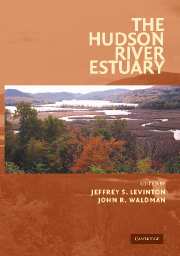Book contents
- Frontmatter
- Contents
- Preface
- List of Contributors
- The Hudson River Estuary
- 1 The Hudson River Estuary: Executive Summary
- GEOLOGICAL, PHYSICAL, AND CHEMICAL SETTING OF THE HUDSON
- PRIMARY PRODUCTION, MICROBIAL DYNAMICS, AND NUTRIENT DYNAMICS OF THE HUDSON
- 8 Bacterial Abundance, Growth, and Metabolism in the Tidal Freshwater Hudson River
- 9 Primary Production and Its Regulation in the Tidal-Freshwater Hudson River
- 10 Wastewater and Watershed Influences on Primary Productivity and Oxygen Dynamics in the Lower Hudson River Estuary
- 11 Modeling Primary Production in the Lower Hudson River Estuary
- HUDSON RIVER COMMUNITIES, FOOD WEBS, AND FISHERIES
- CONTAMINANTS AND MANAGEMENT ISSUES OF THE HUDSON RIVER ESTUARY
- Index
- Plate section
- References
8 - Bacterial Abundance, Growth, and Metabolism in the Tidal Freshwater Hudson River
Published online by Cambridge University Press: 06 January 2010
- Frontmatter
- Contents
- Preface
- List of Contributors
- The Hudson River Estuary
- 1 The Hudson River Estuary: Executive Summary
- GEOLOGICAL, PHYSICAL, AND CHEMICAL SETTING OF THE HUDSON
- PRIMARY PRODUCTION, MICROBIAL DYNAMICS, AND NUTRIENT DYNAMICS OF THE HUDSON
- 8 Bacterial Abundance, Growth, and Metabolism in the Tidal Freshwater Hudson River
- 9 Primary Production and Its Regulation in the Tidal-Freshwater Hudson River
- 10 Wastewater and Watershed Influences on Primary Productivity and Oxygen Dynamics in the Lower Hudson River Estuary
- 11 Modeling Primary Production in the Lower Hudson River Estuary
- HUDSON RIVER COMMUNITIES, FOOD WEBS, AND FISHERIES
- CONTAMINANTS AND MANAGEMENT ISSUES OF THE HUDSON RIVER ESTUARY
- Index
- Plate section
- References
Summary
abstract Free-living, planktonic heterotrophic bacteria comprise a major portion of the living biomass of organisms in the Hudson River. Mean densities of bacteria are 5 × 109 cells/L and abundances generally decrease in a downstream pattern. Bacterial growth is rapid with cells doubling about once per day during the warmer months. Demand for carbon is high and consequently the contribution of bacteria to ecosystem respiration is large, particularly in the mid-Hudson where phytoplankton respiration is low. The high demand for carbon and lack of strong correlation with phytoplankton abundance suggests bacteria are largely reliant on allochthonous carbon delivered from the watershed. Dissolved organic carbon (DOC) dominates the load from the watershed and bacteria have demonstrated roughly equal ability to grow on DOC derived from several different sources and tributaries. Bacterial abundance increased following the zebra mussel invasion in the early 1990s probably due to zebra mussel removal of important grazers on bacteria.
Introduction
In the past twenty years, heterotrophic microorganisms have become widely recognized as integral parts of aquatic ecosystems that play important roles in food webs, nutrient transformations, and organic carbon budgets. Planktonic bacteria can serve as effective links in food webs from dissolved organic matter to larger organisms, although the degree of efficiency varies greatly among aquatic systems (del Giorgio and Cole, 2000). Microbes growing on particulate and dissolved carbon can also act as significant sinks for inorganic nutrients derived from the water column (Caraco et al., 1998).
- Type
- Chapter
- Information
- The Hudson River Estuary , pp. 99 - 106Publisher: Cambridge University PressPrint publication year: 2006
References
- 4
- Cited by



